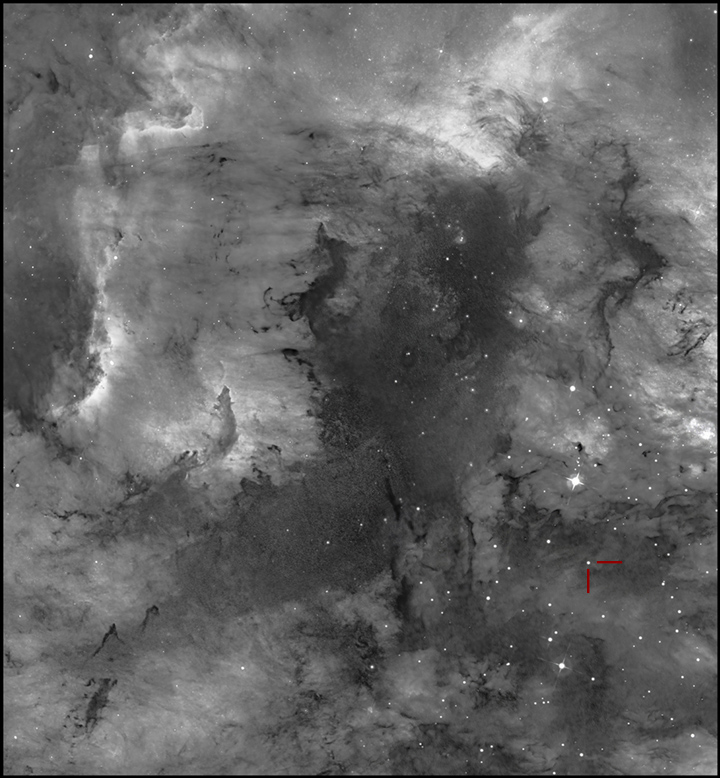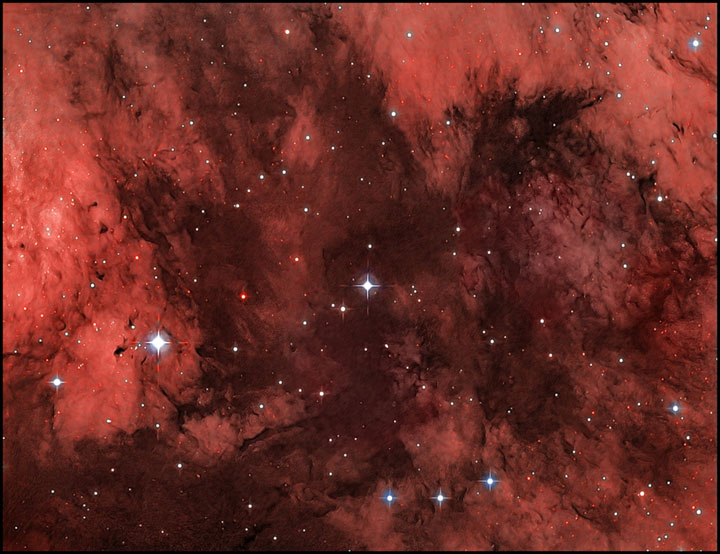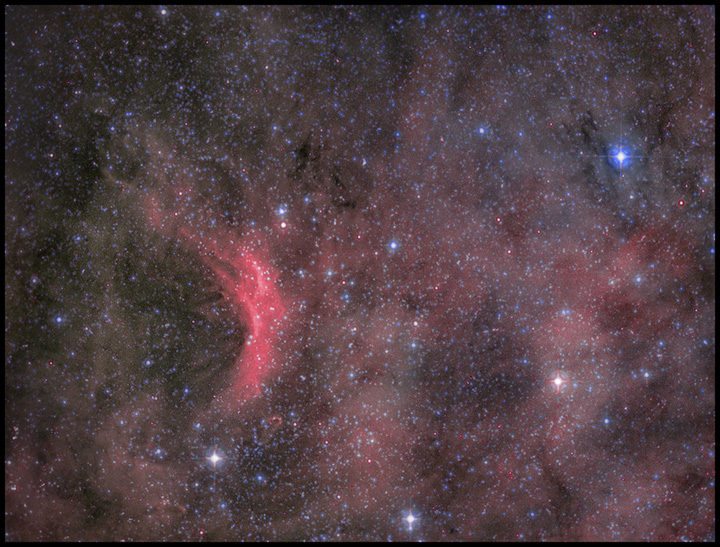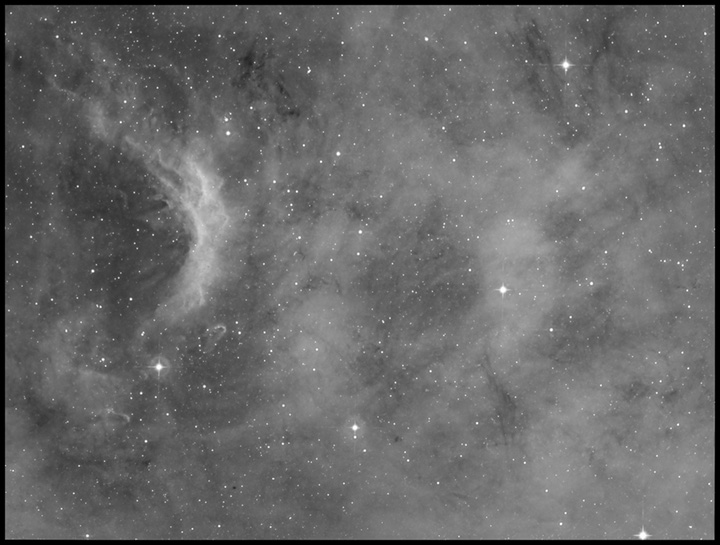The Rediscovery of North America
11/28/2022. A few days back, I went on a rip while ambling around the North America Nebula based largely on research conducted in the first few years of the 21st Century. Earlier this year, in January 2022, J. Maíz Apellániz and three other authors said a great deal more about the star that lights the nebula based largely on data from the Gaia observatory at L2. Their paper is open to all and a companion piece, a brief and approachable article, summarizes their findings.
This is the central part of NGC 7000, a closeup that doesn't reveal the "North America-ness" of the North America Nebula's shape. It does reveal what a complex, tangled and layered region it is. The Bajamar Star is marked by a red cross at lower right. That unremarkable-looking star is faint only because it is masked by thick dust. In reality, it's one of the largest, hottest stars in our part of the Milky Way. Its ultraviolet light ionizes the entire complex, sculpts towers and filaments within the gas, and casts light and shadow through more than a million cubic light-years of creation.

Parts of four photos comprise this look toward the center of
NGC 7000, the North America Nebula. Exposures vary but each is in
the range of 3 hours with a 10-inch R-C and an ASI1600MM camera
working at -15C through a 7nm Baader H-a filter.
Apellániz et al identified the Bajamar Star as one of several "walkaway" stars escaping from a newly formed star cluster in the H-II region that includes both the North America and Pelican Nebulae. Using Gaia's astrometric measurements, spectroscopy, and Monte Carlo modeling of n-body gravitational interactions, the authors identified three ejection events among massive stars. Two events are named for the present geographically analagous locations of displaced stars. The most recent ejection, the Toronto Event, occured 1.5 million years ago. The Bajamar Event occured 1.6 million years ago. The earliest (disappointingly dubbed "HD 201795") took place 1.9 million years ago. All three events displaced multiple stars and occured within the Bermuda star cluster (you get exactly one guess why it is called that), a largely obscured cluster behind the foreground dust shield that forms the "Atlantic." The departure of several massive stars left the Bermuda cluster "orphanized," deprived of its largest members, its total mass cut approximately in half. The depleted cluster may have insufficient mass to bind its remaining stars. That's an open question pending additional astrometric data from Gaia. If the cluster kept too little mass to retain the remaining stars, then they will drift apart and join the general population of the Milky Way.
The brightest and heaviest of the stars ejected from the Bermuda cluster is the Bajamar Star, a double star whose primary component is the most-massive star within 3,000 light-years of Earth (about 73 solar masses, its companion has 25-41). Not only is the intense blue light of the Bajamar Star dimmed by the intervening dust cloud --by a factor of up to 10,000 times -- it is also greatly reddened. The star is inconspicuous in black and white, but in this color photograph, I need only say that it is the bright, very red star left of center:

12x600s Ha + 10x180s R and 10x180s B
AT10RC, ASI1600MM, Baader filters.
Rotated ~90 degrees counter-clockwise compared to the previous image.
Sure, it's clickable.
It is not the only deep red star in that field. The ruby color of other faint stars suggests that they, too, are hidden behind the same veil, perhaps associated with the nebula and not stars that simply happen to lie in our line of sight. In the higher res version, look above and left of the Bajamar Star and toward the lower right corner of the frame.
12/01/2022. I just barely missed the Toronto star in the photos here, so I reshot "Canada" making sure to include it. (12/02: I got an unexpected clear night and doubled the exposure for the black and white shot down below.) I think it's a fascinating contrast with the Bajamar star photograph. The Toronto star is the brilliant blue star in the upper right of this photo:

15 x 600s Ha + 10 x 180s each R and B, G synthesized
Click at will.

28 x 600s H-a, stars removed
and
added back after working on the nebulae.
Like the Bajamar star, this one is also a spectroscopic binary and a walkaway star from an ejection event. It's moving about 30 miles per second away from the Bermuda cluster. Unlike Bajamar, Toronto has walked into the clear, either around or through the obscuring dust shield (LDN 935, aka "the Atlantic") that dims and reddens its fellow escapee. The Toronto star is about 41 times as massive as the Sun. It's slightly cooler than the Bajamar star (38,000 degrees Kelvin compared to 43,000) and "only" about 200,000 times brighter than the Sun (compared to a million). Notice how the towers of gas and dust in the doodad at left point in the direction of the Toronto star but not directly toward it. They actually point to a spot it has already passed along its trajectory -- it takes a while for pillars and towers like those to form, and the star has moved on some since they began to take shape. (Incidentally: 30 miles per second corresponds to about a billion miles per year or a light-year every 5,700 years. That's fast enough to cover some ground.)
12/7/2022. For a better perspective on what convinced Barnard et al that the dark clouds were, in fact, dark clouds, I went looking for a copy of his Atlas of Selected Regions of the Milky Way. The only copies I found were reprints and expansions (very significant expansions) and even those were uncheap. It's just as well that no original turned up on Alibris or Biblio etc because those are priced "astronomically" when they do come to market. The next best thing is here:
https://exhibit-archive.library.gatech.edu/barnard/intro.html
An original copy of Robert Julius Trumpler's 1953 textbook Statistical Astronomy did turn up at a very good price and was delivered today. It looks pristine, as if some student back during the Eisenhower administration gave up in the first week of classes, which, frankly, does not look like a bad idea. It is six hundred pages of heavy stats. More about that by and by.
:: top ::
|